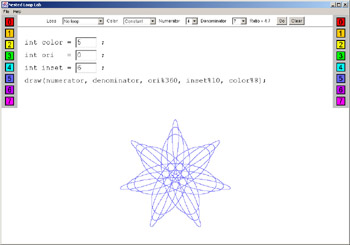The Illustrations are Alive
|
The Illustrations are Alive!
I realized that what I really wanted was a magic blackboard.
Think of a computer as a huge set of boxes, each box containing a number. The numbers represent text or colors or data, or whatever else can be modeled by a program. The numbers change over time in complicated ways. Describing the life cycle of a program is almost impossible if you can only use words and pictures. I wanted to create pictures that would change over time. And I wanted something beyond animated cartoons that would be the same each time you watched them. I wanted living illustrations that would respond to your curiosity. I wanted to give you the power to ask “what if …” questions of the illustrations.
I wanted something that can only be done on a computer.
The CD-ROM that comes with this book has more than 30 animated illustrations. These are programs that you run on your computer. The book gives you complete instructions on how to use them. The illustration on the next page is an example.

This is a screenshot of NestedLoopLab, which appears in Chapter 5, “Conditionals and Loops.” The text in the upper-central part of the screen (“int color = 5” and so on) is Java code. The swirly image at the bottom is the result of running the code. The various controls let you vary the code, experimenting with different values until you get a feel for what the program is doing.
The animated illustrations are like training wheels on a bicycle. When you first learn to ride, there are so many things that can go wrong. Without training wheels you spend a lot of just time crashing and getting back up. Training wheels let you develop the right sense of balance. The animated illustrations won’t let you create code that crashes. They provide a safe environment in which you can develop the right sense of balance.
Later, of course, it’s time to take off the training wheels. At the end of each chapter you’ll find a set of exercises that will have you writing your own code. Suggested solutions to the exercises appear at the back of the book.
To the best of my knowledge, Ground-Up Java is the first book ever to use animated illustrations. So we have no data on how effective they are as a teaching tool. My guess is that they are worth their weight in gold. Everyone who has seen them has been very enthusiastic. But you are the most qualified judge. Try them! Please let me know what you think. You can e-mail your comments to groundupjava@sgsware.com. I’m especially interested in knowing which animated illustrations worked the best for you, and which ones didn’t. I’d also like to hear any suggestions you might have for more animations to appear in future revisions of this book. You are invited to be part of the development of animated illustrations as a new technology for learning.
And now…
|